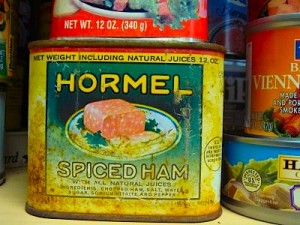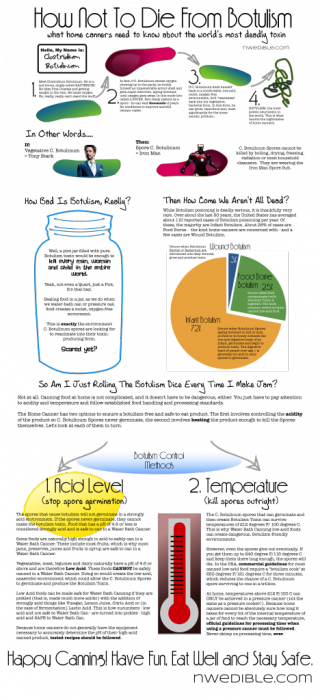 We have all heard of the canned food that was still edible after 50, 75, or 100 years. Of course, most of us would be too chicken to eat it. We have grown fearful. In part because we understand there are risks from cans that are compromised; where changes in pH lead to an environment that breeds botulism or other poisons. But we have also allowed ourselves to be browbeaten by the food industry and its attorneys, who try to cover their backsides by adding a “best before” date to the cans to limit their liability in the event of a problem. This poses a significant burden to the American food system.
We have all heard of the canned food that was still edible after 50, 75, or 100 years. Of course, most of us would be too chicken to eat it. We have grown fearful. In part because we understand there are risks from cans that are compromised; where changes in pH lead to an environment that breeds botulism or other poisons. But we have also allowed ourselves to be browbeaten by the food industry and its attorneys, who try to cover their backsides by adding a “best before” date to the cans to limit their liability in the event of a problem. This poses a significant burden to the American food system.
So what’s the real story?
From the National Center for Home Food Preservation website,
Properly canned food stored in a cool, dry place will retain optimum eating quality for at least 1 year. Canned food stored in a warm place near hot pipes, a range, a furnace, or in indirect sunlight may lose some of its eating quality in a few weeks or months, depending on the temperature. Dampness may corrode cans or metal lids and cause leakage so the food will spoil.
Does that mean that canned goods are done in one year? Nope. Many foods will last far longer than that. You just need to know what to look for.
How about this for a great story. Dale Blumenthal, a staff writer for the FDA, wrote:
The steamboat Bertrand was heavily laden with provisions when it set out on The Missouri River in 1865, destined for the gold mining camps in Fort Benton, Mont. The boat snagged and swamped under the weight, sinking to the bottom of the river. It was found a century later, under 30 feet of silt a little north of Omaha, Neb.
Among the canned food items retrieved from the Bertrand in 1968 were brandied peaches, oysters, plum tomatoes, honey, and mixed vegetables. In 1974, chemists at the National Food Processors Association (NFPA) analyzed the products for bacterial contamination and nutrient value. Although the food had lost its fresh smell and appearance, the NFPA chemists detected no microbial growth and determined that the foods were as safe to eat as they had been when canned more than 100 years earlier.
The nutrient values varied depending upon the product and nutrient. NFPA chemists Janet Dudek and Edgar Elkins report that significant amounts of vitamins C and A were lost. But protein levels remained high, and all calcium values “were comparable to today’s products.”
NFPA chemists also analyzed a 40-year-old can of corn found in the basement of a home in California. Again, the canning process had kept the corn safe from contaminants and from much nutrient loss. In addition, Dudek says, the kernels looked and smelled like recently canned corn.
Basic commonsense suggests you:
Look at the can. Food in damaged or rusting cans has a higher chance of being contaminated than cans in good condition. Do not eat food from cans that are bulging, dented, leaking or sticky or super rusted.
In the case of glass jars, check the food’s color. Some color change over time is normal, but a big alteration in color or a lack of color signals a problem.
For preserved fruit, pickles and relishes, check the syrup or brine. If it’s cloudy, opaque or looks like the liquid has evaporated away, give it a miss.
Dump anything with a damaged lid. Microorganisms can get in and affect the pH level and lead to poisoning.
Open the can. Throw it away if liquid spurts out when you open the can. Then, check the surface for mold or scum.
Smell the food. Dump anything that smells “off” or just unusual.
Taste it. If it’s old it might have lost some flavor. Don’t eat all of it at once. Taste some and wait a while to see if you feel OK. Basically, if you have a bad feeling about it, toss it.
Here are some additional guidelines for canned food storage.
Low-acidic foods Canned meats can last longer than canned fruits and vegetables. Most canned meats will keep for two to five years or even longer. Other long-lasting canned low-acid foods are soups (without tomatoes), carrots, pumpkin, potatoes and peas.
 High-acidic foods High-acidic foods include tomatoes and fruit and canned foods that contain vinegar. Although these foods may taste the best and have the best nutrition within a year or so, many of them are edible after years of storage.
High-acidic foods High-acidic foods include tomatoes and fruit and canned foods that contain vinegar. Although these foods may taste the best and have the best nutrition within a year or so, many of them are edible after years of storage.
Storage requirements The main reason canned foods spoil is improper storage. Cool, dry storage is best.
Microorganisms can grow and thrive in cans stored in damp areas and in high temperatures (over 95°F). These microorganisms can spoil the food and/or alter the food, enabling other microorganisms like botulism to grow. Click the infographic to find out how not to get botulism!
Keep canned foods away from sunlight as the heat can cause the air in the can to expand and bust the seal, again allowing microorganisms to poison the food. In addition, sunlight can turn oil or fats rancid.
There are no hard and fast rules about how long canned foods last. According to the NRDC study,
The waste of edible food by consumers, retailers and manufacturers poses a significant burden to the American food system. Wasted food costs consumers and industry money; squanders important natural resources that are used to grow, process, distribute, and store America’s food supply; and represents a missed opportunity to feed the millions of food insecure households in the United States that are struggling to access healthy, affordable food. Misinterpretation of the date labels on foods is a key factor leading to this waste.
And here is an official guide to storing food. Daredevils can ignore it at their own risk!
